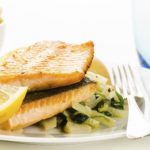Is There Fish Oil in Farmed Salmon?
I know you recommend wild Alaskan salmon, but it is very expensive so I’ve been buying farmed salmon. Now I hear that farmed salmon doesn’t give you the same quality fish oil available in wild salmon. True?
Andrew Weil, M.D. | March 3, 2015

True. I am not a fan of farmed salmon, which I’ll discuss below, but you should know that the amount of beneficial omega-3 fatty acids available in salmon and their oil comes from their diets. Wild salmon get these fats from the plankton and small fish they consume naturally in the ocean, and farmed salmon get them from their feed. However, according to the International Fishmeal and Fish Oil Organisation (IFFO), at least some farmed salmon feed no longer contains the optimum amount of omega 3 oils; instead, cheaper vegetable oils are used. This is not good news, since it means that if you eat farmed salmon (which I generally discourage) you may no longer get the amount of omega-3s farmed salmon used to deliver.
My objection to farmed salmon predates this latest information about the substitution of vegetable oil in salmon feed. I find that most farmed salmon has less flavor, as well as less protein, than wild salmon. More importantly, farmed fish are also likely to contain residues of pesticides, antibiotics and other drugs used to control diseases that occur when fish are crowded together in the pens of fish farms. Those diseases may escape and decimate wild populations of salmon. Most people assume that fish farming is a way of protecting an endangered resource. Few know of its negative impact on the environment, or that it takes several pounds of feed fish to produce one pound of salmon. The net result of salmon farming is greatly accelerated depletion of the numbers of fish in the oceans.
That said, some salmon farming is being done responsibly and is producing higher quality product more like wild fish.
As far as omega-3 fatty acids are concerned, most Americans are deficient and as a result are more likely to develop cardiovascular disease, cancer, inflammatory disorders, and mental and emotional problems. Supplementing the diet with omega-3 fatty acids not only can reduce these risks but can also help address depression, bipolar disorder, autism, and attention deficit hyperactivity disorder.
If you can’t afford wild Alaskan salmon because of its cost, you can get omega-3s from other cold water fish – herring (including canned, smoked kippers), mackerel and sardines, which are the safest and best fish sources of omega-3s other than wild salmon. I am especially fond of fresh sardines, grilled with nothing but salt and lemon juice, and I’m happy to see them increasingly available. (I used to be able to get them only in better Greek and Italian restaurants.) I also buy canned smoked kippers and water- or olive-oil-packed canned sardines and mash them up with mustard, lemon juice, and onion as a spread. Give that a try; it’s an easy way to get some safe fatty fish into your diet.
You can also get omega-3s from canned salmon. Look for sockeye salmon from Alaska; all of it is wild. It’s convenient to have on hand when you can’t get good quality fresh salmon.
Andrew Weil, M.D.
SOURCE:
“IFFO Launches New Video On The Importance Of Omega-3s In Salmon Feed.” http://www.iffo.net/node/690









